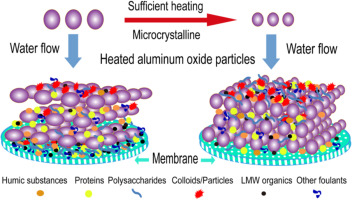当前位置:
X-MOL 学术
›
J. Membr. Sci.
›
论文详情
Our official English website, www.x-mol.net, welcomes your
feedback! (Note: you will need to create a separate account there.)
Mitigation of NOM Fouling of Ultrafiltration Membranes by Pre-deposited Heated Aluminum Oxide Particles with Different Crystallinity
Journal of Membrane Science ( IF 8.4 ) Pub Date : 2017-12-01 , DOI: 10.1016/j.memsci.2017.09.048 Ting Liu , Bing Yang , Nigel Graham , Yuanlong Lian , Wenzheng Yu , Kening Sun
Journal of Membrane Science ( IF 8.4 ) Pub Date : 2017-12-01 , DOI: 10.1016/j.memsci.2017.09.048 Ting Liu , Bing Yang , Nigel Graham , Yuanlong Lian , Wenzheng Yu , Kening Sun

|
Abstract A major cause of ultrafiltration (UF) membrane fouling in surface water treatment is natural organic matter (NOM). Some studies have reported that heated aluminum oxide particles (HAOPs), prepared by boiling a suspension containing precipitates of the common coagulant alum, can remove substantial amounts of NOM and reduce fouling when they were pre-deposited on UF membranes. However, the influence of the size and structure of the HAOPs in mitigating NOM membrane fouling has not been fully explored so far. This work has investigated the change in microstructure of the HAOPs during the heating process and the subsequent effect on the performance of the membrane process, and especially on the mitigation of fouling. As the heating time increased, the structure of the HAOPs transformed gradually from an amorphous nature to a semi-crystal, and then to a microcrystalline phase. It was found that this micro-crystallization process played a key role in affecting the structural properties of the nano-scale particles and the membrane filtration performance. During the crystalline transition, a change of particle size distribution occurred and the average particle size was found to decrease gradually owing to a dehydration reaction. The smaller particle size of the HAOPs provides a denser pre-filtration layer for NOM separation, and their more rigid structure reduces layer compression and hydraulic resistance during operation. Optimization of the pre-heating condition and surface loading can effectively enhance the performance of the HAOPs layer in reducing NOM fouling in the UF membrane system.
中文翻译:

不同结晶度的预沉积加热氧化铝颗粒减轻超滤膜的 NOM 污染
摘要 地表水处理中超滤(UF)膜污染的主要原因是天然有机物(NOM)。一些研究报告称,加热氧化铝颗粒 (HAOP) 是通过煮沸含有普通凝结剂明矾沉淀物的悬浮液制备的,当它们预先沉积在超滤膜上时,可以去除大量的 NOM 并减少结垢。然而,到目前为止,HAOP 的大小和结构对减轻 NOM 膜污染的影响尚未得到充分探索。这项工作研究了加热过程中 HAOP 微观结构的变化以及对膜过程性能的后续影响,特别是对减少污染的影响。随着加热时间的增加,HAOPs的结构逐渐从无定形转变为半晶体,然后变成微晶相。发现这种微晶化过程在影响纳米级颗粒的结构特性和膜过滤性能方面起着关键作用。在结晶转变过程中,粒径分布发生变化,平均粒径由于脱水反应而逐渐减小。HAOP 的较小粒径为 NOM 分离提供了更致密的预过滤层,其更刚性的结构降低了操作过程中的层压缩和水力阻力。预热条件和表面负载的优化可以有效提高HAOPs层在减少超滤膜系统NOM污染方面的性能。发现这种微晶化过程在影响纳米级颗粒的结构特性和膜过滤性能方面起着关键作用。在结晶转变过程中,粒径分布发生变化,平均粒径由于脱水反应而逐渐减小。HAOP 的较小粒径为 NOM 分离提供了更致密的预过滤层,其更刚性的结构降低了操作过程中的层压缩和水力阻力。预热条件和表面负载的优化可以有效提高HAOPs层在减少超滤膜系统NOM污染方面的性能。发现这种微晶化过程在影响纳米级颗粒的结构特性和膜过滤性能方面起着关键作用。在结晶转变过程中,粒径分布发生变化,平均粒径由于脱水反应而逐渐减小。HAOPs 的较小粒径为 NOM 分离提供了更致密的预过滤层,其更刚性的结构减少了操作过程中的层压缩和水力阻力。预热条件和表面负载的优化可以有效提高HAOPs层在减少超滤膜系统NOM污染方面的性能。在结晶转变过程中,粒径分布发生变化,平均粒径由于脱水反应而逐渐减小。HAOP 的较小粒径为 NOM 分离提供了更致密的预过滤层,其更刚性的结构降低了操作过程中的层压缩和水力阻力。预热条件和表面负载的优化可以有效提高HAOPs层在减少超滤膜系统NOM污染方面的性能。在结晶转变过程中,粒径分布发生变化,平均粒径由于脱水反应而逐渐减小。HAOP 的较小粒径为 NOM 分离提供了更致密的预过滤层,其更刚性的结构降低了操作过程中的层压缩和水力阻力。预热条件和表面负载的优化可以有效提高HAOPs层在减少超滤膜系统NOM污染方面的性能。并且它们更坚固的结构减少了操作过程中的层压缩和水力阻力。预热条件和表面负载的优化可以有效提高HAOPs层在减少超滤膜系统NOM污染方面的性能。并且它们更坚固的结构减少了操作过程中的层压缩和水力阻力。预热条件和表面负载的优化可以有效提高HAOPs层在减少超滤膜系统NOM污染方面的性能。
更新日期:2017-12-01
中文翻译:

不同结晶度的预沉积加热氧化铝颗粒减轻超滤膜的 NOM 污染
摘要 地表水处理中超滤(UF)膜污染的主要原因是天然有机物(NOM)。一些研究报告称,加热氧化铝颗粒 (HAOP) 是通过煮沸含有普通凝结剂明矾沉淀物的悬浮液制备的,当它们预先沉积在超滤膜上时,可以去除大量的 NOM 并减少结垢。然而,到目前为止,HAOP 的大小和结构对减轻 NOM 膜污染的影响尚未得到充分探索。这项工作研究了加热过程中 HAOP 微观结构的变化以及对膜过程性能的后续影响,特别是对减少污染的影响。随着加热时间的增加,HAOPs的结构逐渐从无定形转变为半晶体,然后变成微晶相。发现这种微晶化过程在影响纳米级颗粒的结构特性和膜过滤性能方面起着关键作用。在结晶转变过程中,粒径分布发生变化,平均粒径由于脱水反应而逐渐减小。HAOP 的较小粒径为 NOM 分离提供了更致密的预过滤层,其更刚性的结构降低了操作过程中的层压缩和水力阻力。预热条件和表面负载的优化可以有效提高HAOPs层在减少超滤膜系统NOM污染方面的性能。发现这种微晶化过程在影响纳米级颗粒的结构特性和膜过滤性能方面起着关键作用。在结晶转变过程中,粒径分布发生变化,平均粒径由于脱水反应而逐渐减小。HAOP 的较小粒径为 NOM 分离提供了更致密的预过滤层,其更刚性的结构降低了操作过程中的层压缩和水力阻力。预热条件和表面负载的优化可以有效提高HAOPs层在减少超滤膜系统NOM污染方面的性能。发现这种微晶化过程在影响纳米级颗粒的结构特性和膜过滤性能方面起着关键作用。在结晶转变过程中,粒径分布发生变化,平均粒径由于脱水反应而逐渐减小。HAOPs 的较小粒径为 NOM 分离提供了更致密的预过滤层,其更刚性的结构减少了操作过程中的层压缩和水力阻力。预热条件和表面负载的优化可以有效提高HAOPs层在减少超滤膜系统NOM污染方面的性能。在结晶转变过程中,粒径分布发生变化,平均粒径由于脱水反应而逐渐减小。HAOP 的较小粒径为 NOM 分离提供了更致密的预过滤层,其更刚性的结构降低了操作过程中的层压缩和水力阻力。预热条件和表面负载的优化可以有效提高HAOPs层在减少超滤膜系统NOM污染方面的性能。在结晶转变过程中,粒径分布发生变化,平均粒径由于脱水反应而逐渐减小。HAOP 的较小粒径为 NOM 分离提供了更致密的预过滤层,其更刚性的结构降低了操作过程中的层压缩和水力阻力。预热条件和表面负载的优化可以有效提高HAOPs层在减少超滤膜系统NOM污染方面的性能。并且它们更坚固的结构减少了操作过程中的层压缩和水力阻力。预热条件和表面负载的优化可以有效提高HAOPs层在减少超滤膜系统NOM污染方面的性能。并且它们更坚固的结构减少了操作过程中的层压缩和水力阻力。预热条件和表面负载的优化可以有效提高HAOPs层在减少超滤膜系统NOM污染方面的性能。











































 京公网安备 11010802027423号
京公网安备 11010802027423号